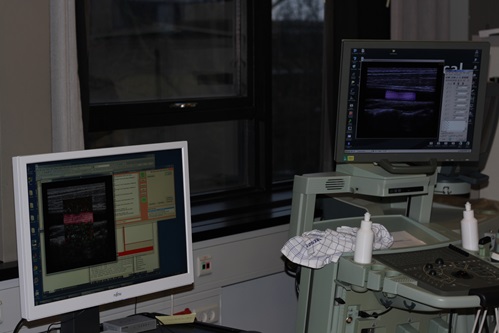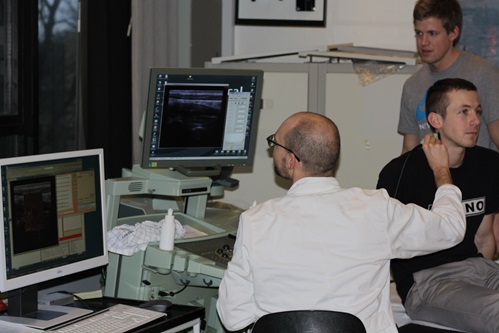Ultrasonic flow estimation is widely used to evaluate the blood flow in the human body. This allows medical doctors to evaluate the function of the cardiovascular system.
 At CFU, we strive to develop new techniques, and improve existing ones, to yield more precise images of the complex flow patterns. This includes techniques for three-dimensional (3-D) vector flow imaging as illustrated. Another focus area is to make faster flow images and do real-time vector flow imaging to visualize the various dynamics in the human circulatory system.
At CFU, we strive to develop new techniques, and improve existing ones, to yield more precise images of the complex flow patterns. This includes techniques for three-dimensional (3-D) vector flow imaging as illustrated. Another focus area is to make faster flow images and do real-time vector flow imaging to visualize the various dynamics in the human circulatory system.
This is pivotal as it is well established that flow patterns change rapidly throughout the cardiac cycle. The direction and magnitude also changes depending on the spatial location. However, conventional methods only estimate flow components towards or away from the transducer. This poses a huge challenge for quantitatively measuring the magnitude (and direction) of the blood’s velocity. This problem has been acknowledged for many years and a large number of techniques have been proposed to solve this.
 Several years ago, The Transverse Oscillation (TO) method was developed at CFU - a method for estimating the velocity vector in the image plane. The method has been implemented by BK Medical on their commercial scanners and has been FDA approved for clinical use. Nowadays, the research focuses on expending the TO technique to other transducer geometries and improving the precision. Effort is also put into implementing the technique in OpenCL to allow real-time visualization using the experimental research scanner SARUS for data acquisition.
Several years ago, The Transverse Oscillation (TO) method was developed at CFU - a method for estimating the velocity vector in the image plane. The method has been implemented by BK Medical on their commercial scanners and has been FDA approved for clinical use. Nowadays, the research focuses on expending the TO technique to other transducer geometries and improving the precision. Effort is also put into implementing the technique in OpenCL to allow real-time visualization using the experimental research scanner SARUS for data acquisition.
The TO approach has been extended to full 3-D imaging by using a 2-D matrix transducer. The technique has been implemented on SARUS and measurements have been conducted on a circulating flow-rig, on phantoms and in-vivo. This is still an active research area with focus on visualizing the complex flow patterns and proving quantitative measures of the volumetric flow rates in-vivo.
Effort is also being put into the developement of algorithms using synthetic aperture (SA) or synthetic aperture sequential beamforming (SASB) in combination with directional beamforming and duplex imaging techniques to yield high-frame rate flow imaging. The purpose is to expand the dynamic range of flow estimators to allow visualization of both rapid and slow flow.
Research within this area is performed by